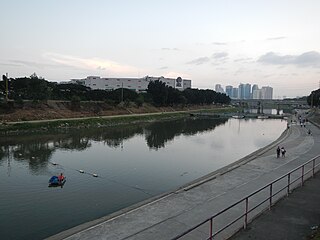
Rizal, officially known as the Province of Rizal, is a province in the Philippines located in the Calabarzon region, 16 kilometres (9.9 mi) east of Manila. The province is named after José Rizal, one of the main national heroes of the Philippines. Rizal is bordered by Metro Manila to the west, Bulacan to the north, Quezon to the east and Laguna to the southeast. The province also lies on the northern shores of Laguna de Bay, the largest lake in the country. Rizal is a mountainous province perched on the western slopes of the southern portion of the Sierra Madre mountain range.

Rodriguez, Rizal, is a 1st class municipality in the province of Rizal, Philippines. It was formerly known as and is still commonly referred to as Montalban. According to the 2015 census, it has a population of 369,222 people making it the most populous municipality in the country.

Pasig, officially the City of Pasig,, or simply known as Pasig City, is a 1st class highly urbanized city in Metro Manila, Philippines. According to the 2015 census, it has a population of 755,300 people.

Marikina,, officially the City of Marikina,, or simply known as Marikina City, is a 1st class highly urbanized city in Metro Manila, Philippines. According to the 2015 census, it has a population of 450,741 people.

Antipolo, officially the City of Antipolo,, or simply known as Antipolo City, is a 1st class city and the capital of the province of Rizal, Philippines. According to the 2015 census, it has a population of 776,386 people.

San Mateo, officially the Municipality of San Mateo,, is a 1st class municipality in the province of Rizal, Philippines. According to the 2015 census, it has a population of 579,925. It is bordered by Quezon City to the west, the cities of Marikina and Antipolo to the south, and to the north by the municipality of Rodriguez. San Mateo is approximately 24 kilometres (15 mi) east of Manila and 11 kilometres (6.8 mi) north of Pasig, the former provincial capital of Rizal.

Cainta, officially the Municipality of Cainta,, is a 1st class municipality in the province of Rizal, Philippines. According to the 2015 census, it has a population of 322,128 people.

Taytay, officially the Municipality of Taytay,, is a 1st class municipality in the province of Rizal, Philippines. According to the 2015 census, it has a population of 319,104 people.
The Legislative Districts of Rizal, namely the first and second districts are the representations of the Province of Rizal in the Philippine House of Representatives. From 1907 to 1972, the present-day municipality of Pateros and the cities of Caloocan, Las Piñas, Makati, Malabon, Mandaluyong, Marikina, Muntinlupa, Navotas, Parañaque, Pasay, Pasig, Quezon City, San Juan and Taguig and, until 1998, Antipolo City were part of its representation. From 1978 to 1984, it was part of the representation of Region IV-A in the Interim Batasang Pambansa, and from 1984 to 1986, it elected 2 assemblymen at-large in the Regular Batasang Pambansa.

Rizal Technological University (RTU) is a state university located at Mandaluyong, Philippines. It was established on July 11, 1969 as the College of Rizal, part of the University of Rizal System before it became autonomous in 1975. The state university is also the first educational institution in the country to use cooperative education as a curriculum plan which is recognized by various industries, businesses and agencies all over the country. The university has various different academic fields, and focuses primarily on architecture, engineering, and technology programs.

Marikina River is a river in eastern Metro Manila, Philippines. It is a tributary of Pasig River with headwaters located in the Sierra Madre Mountains in Rodriguez, Rizal province.

The National Christian Life College (NCLC), formerly the Maranatha Christian Academy (MCA), is a private, non-stock, non-sectarian Christian school, with its main campus in Marikina City, Philippines. It was established in February 1980 by Dr. Leticia S. Ferriol, who is the directress of the school. It is part of the Pentecostal Missionary Church of Christ headed by Arsenio Ferriol.

The Roman Catholic Diocese of Antipolo is a diocese of the Latin rite of the Roman Catholic Church in the Philippines that comprises the Province of Rizal and the city of Marikina in Metro Manila.

Ortigas Avenue is a 15.5 km highway traversing through the eastern part of Metro Manila and the western part of Rizal province. It is one of the busiest highways in Metro Manila.

The Upper Marikina River Basin Protected Landscape is a protected area in the Province of Rizal in the Philippines, which forms the upper area of the drainage basin of the Marikina River.

SM City San Mateo is a shopping mall owned by the largest mall developer in the Philippines, SM Prime Holdings. It is located along Gen. Luna Avenue, Brgy. Ampid 1, San Mateo, Rizal. This first major mall of San Mateo opens on 15 May 2015, being the fourth SM Supermall in Rizal Province after SM City Taytay, SM City Masinag and SM Center Angono, and the 52nd SM Supermall in the country. The mall is designed by JRP Design Inc., a local architectural design firm in Ayala Alabang, Muntinlupa and DSGN associates, a firm based in Dallas, Texas, United States, which also designed SM City Marikina.

Radial Road 5, more commonly referred to as R-5, is a network of roads and bridges that altogether form the fifth radial road of Manila in the Philippines. The road links the City of Manila with Mandaluyong and Pasig in the east, leading out of Metro Manila into the province of Rizal and south towards Laguna. It is the only arterial road traversing the east side of the Laguna de Bay.

















